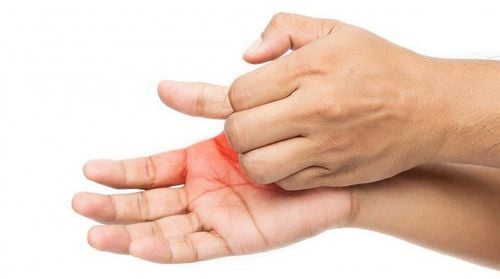This is an automatically translated article.
Chronic pain is long-lasting pain that may not respond well to traditional treatment options, so you may want to try complementary and alternative medications. Alternative treatment is a term used for practices and therapies that are not currently considered part of conventional medicine. Here are alternative treatments for long-term pain you need to know about.
1. What are alternative treatments for chronic pain?
If you have always suffered from chronic pain and are looking for alternatives to medication or surgery, you have many options.
Not all alternative chronic pain treatments are effective. Some may even face many risks. Some alternative treatments can help relieve pain from poor posture, osteoarthritis, and headaches, but have no effect on chronic pain from fibromyalgia or nerve damage from diabetes. Street .
Dr Anne Louise Oaklander, associate professor of neurology at Harvard Medical School and director of the Nervous Injury Unit at Massachusetts General Hospital in Boston, warns: "You have to regularly do pain-relieving exercises. at home while considering alternative treatments for pain Make sure you are trying a treatment that is likely to work in your particular case And always discuss with your doctor about any alternative pain treatment you want to try before doing it.”
2. Alternative treatments for long-term pain
Below is a list of the most commonly used alternative treatments for chronic pain
2.1. Acupuncture
Once considered a strange method and questioned for its effectiveness, today, acupuncture is rapidly becoming a mainstream treatment for pain relief. Studies have found that acupuncture works for pain caused by many medical conditions, including fibromyalgia, osteoarthritis, back injuries, and sports injuries.
The mechanism of action of acupuncture in pain relief has not been elucidated. However, scientists hypothesize that acupuncture can release numbing chemicals in the body. Or it can block pain signals coming from nerves.
Professor F. Michael Ferrante, Director of the UCLA Center for Pain Management in Los Angeles, said: “I think there's relatively strong scientific evidence that acupuncture can relieve pain, and I usually go for it. this. Another plus of acupuncture is that even if it doesn't work for chronically sore muscles, it doesn't do any harm."

Châm cứu là một trong nhiều phương pháp điều trị thay thế
2.2. Marijuana
Controversy aside, cannabis has been shown to have medicinal properties and can help treat certain types of chronic pain. “There is strong evidence that cannabis has a mild effect on some types of neuropathic pain — especially in neuropathic pain,” says Steven P. Cohen, associate professor of pain medicine at the Johns Hopkins School of Medicine in Baltimore. pain caused by MS and HIV. As it also relieves nausea, cannabis can be of great help to people who are suffering from the side effects of chemotherapy.”
However, using marijuana also involves many risk factors. For some people, those risks can be serious, Cohen says, including addiction and psychosis. Because of the obvious dangers and potential abuses marijuana can bring, professionals often turn to marijuana only when all other treatments have failed. On a practical level, you also need to know that the laws regarding the use of medical marijuana in your country are very strict. You can be arrested for smoking marijuana for any reason. Therefore, you should consult your doctor first. There are also two prescription drugs, known as pharmaceutical cannabinoids, that are derived from the active ingredient of cannabis. They are sometimes used for pain relief, although they are only approved by the Food and Drug Administration for the treatment of chemotherapy-induced nausea and HIV-related weight loss.
2.3. Do exercise
Exactly, walking is not a treatment. Regular physical activity is of great benefit to people with a variety of chronic pain conditions. These findings follow research that has shown that physical activity can help relieve chronic pain, as well as boost energy and mood.
If you suffer from chronic pain, you should see your doctor before starting an exercise routine, especially if you have any other health problems. Your doctor may have some guidelines for what to avoid, at least when you start doing exercises.

Hoạt động thể chất giúp điều trị nhiều chứng đau mãn tính
2.4. Chiropractic adjustment
Although conventional mainstream medicine is skeptical of chiropractic, it is becoming a more accepted treatment. “I think chiropractic works for low back pain,” says Dr. Oaklander. Studies have shown that it is even comparable to other treatments."
2.5. Supplements and vitamins
There is evidence that certain supplements and vitamins and minerals can help relieve some types of pain. Fish oil is often used to relieve pain caused by swelling. Topical capsaicin, derived from chili peppers, can help with arthritis, diabetic nerve pain, and other conditions. There is evidence that glucosamine can help relieve moderate to severe pain from osteoarthritis in the knee.
But when it comes to supplements, it's important to exercise caution. They can be potentially dangerous. Dr. Oaklander says that high doses of vitamin B6 can damage nerves. Some research suggests that supplements like ginkgo biloba and ginseng may thin the blood and increase the risk of bleeding. This can have serious consequences for anyone undergoing surgery for chronic pain.
Ferrante says: “Supplements can do real harm. He points out that people with chronic pain may be at higher risk of side effects from supplements. Therefore, always discuss carefully with your doctor about the drugs you want to use to avoid unwanted side effects.
2.6. Therapy
Some people with chronic pain don't want to see a therapist - they think it's a hint that their pain isn't real. But studies show that depression and chronic pain often co-occur. Chronic pain can cause or worsen depression, and depression can decrease a person's pain tolerance. So consider trying a therapy. Cohen says he's seen particularly good results with cognitive behavioral therapy, a practical approach that helps people identify and change thought and behavior patterns that contribute to anxiety and stress. their straight.

Trị liệu giúp nhận thức được hành vi
2.7. Stress reduction techniques.
Stress reduction is really important in pain management. Some commonly used stress-reduction strategies to help manage pain include:
Yoga: Scientists have found plenty of evidence that yoga can help relieve chronic pain - specifically fibromyalgia. chemistry, neck pain, back pain and arthritis. “I have considered yoga as part of the therapy I have used to treat chronic pain patients since the mid-1980s,” says Dr. Savage. Relaxation Therapy: This is actually a type of technique that helps people calm their bodies and release stress - an effective pain reliever. One of the key elements of relaxation therapy is that it teaches the practitioner how to control and regulate breathing. Research shows that relaxation therapy can help with fibromyalgia, headaches, osteoarthritis, and other chronic conditions. Hypnosis: Studies have found hypnosis to be helpful with different types of pain, such as back pain, repetitive stress injuries, and cancer pains. Focus on specific images: Research shows that instructing patients to focus on specific images can help with conditions such as headaches, cancer pain, osteoarthritis, and fibromyalgia. A specialist will instruct the patient to direct his or her thoughts by focusing on specific images. Music therapy: This treatment is based on soothing music. Studies have found that it can help treat a variety of painful conditions, like osteoarthritis and cancer. Biofeedback: This method teaches the patient how to unconsciously control normal bodily functions, such as their blood pressure or heart rate. Studies have found that it can help with headaches, fibromyalgia, and other conditions. Massage: Undeniably massage is one of the methods to bring about a very relaxing feeling. There is some evidence that massage can help relieve pain from rheumatoid arthritis, neck and back injuries, and fibromyalgia. Now, alternative methods of treating chronic pain are increasingly becoming available. should be popular. Part of this is because traditional treatments such as medication or surgery have shown to be ineffective and costly. Besides, many people also do not want to depend too much on medication to control pain. Alternative treatments have also been shown to be effective in managing chronic pain in a healthy and minimally invasive manner.
Please dial HOTLINE for more information or register for an appointment HERE. Download MyVinmec app to make appointments faster and to manage your bookings easily.
References: webmd.com, everydayhealth.com













